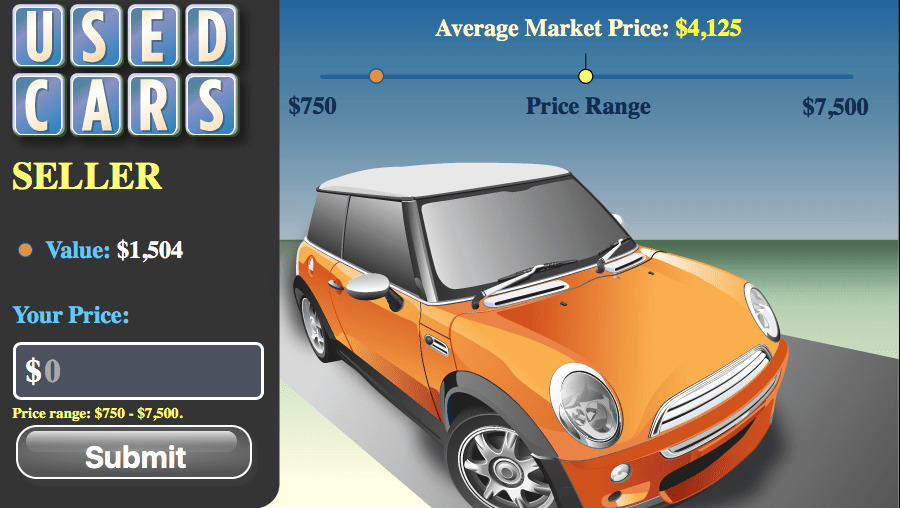12.2 Adverse Selection in the Labor Market
The problem of adverse selection in the insurance market is just one of many cases where the less informed party is the seller of the good or service. Another classic example is the credit market, which we will examine in Chapter 14: banks must decide whether to grant a loan without knowing for sure the borrower’s reliability. Another case is that of public concessions, where the State sells rights over resources to private firms whose true value is better known by the buyer.
In many other contexts,
 George Akerlof (Nobel Prize in Economics, 2001) was the first to formalize the problem in his article The Market for Lemons, which analyzes the market for used cars.
it is instead the buyer who has less information, and almost all real markets may be affected by this asymmetry. It is hard to claim that the average consumer knows the characteristics of what they purchase — such as the quality and composition of a food item, or the reliability and durability of an appliance — as well as the producer does.
George Akerlof (Nobel Prize in Economics, 2001) was the first to formalize the problem in his article The Market for Lemons, which analyzes the market for used cars.
it is instead the buyer who has less information, and almost all real markets may be affected by this asymmetry. It is hard to claim that the average consumer knows the characteristics of what they purchase — such as the quality and composition of a food item, or the reliability and durability of an appliance — as well as the producer does.
Among the many possible examples, in this section we will focus on a particularly important case: the labor market. Here, the buyer is the employer, who is interested in hiring productive workers. However, before hiring, the firm does not know the candidate’s true productivity. As we will see, this informational asymmetry generates inefficient allocations similar to those observed in the insurance market.
Observable Productivity
Let us consider a competitive labor market in which the supply side consists of two equally sized groups of workers: group $A$, composed of high-productivity workers, and group $B$, composed of low-productivity workers. Hiring a worker from group $A$ gives the firm a marginal labor revenue of $90$, while hiring one from group $B$ yields a revenue of $60$. We make the realistic — though non-essential — assumption that more productive workers also have better outside options. Thus, although the two groups are equally large, at any given wage $W$ the number of group $A$ workers willing to work, that is $Q_A=(W-50)/2$, is smaller than the number of group $B$ workers, which is $Q_B=W-50$.
Within each group, workers differ in terms of their reservation utility, which is reflected in the labor supply functions of the two groups: \(W = 50 + 2Q_A \qquad W = 50 + Q_B\) where $Q_A$ and $Q_B$ denote, respectively, the number (in thousands) of workers from groups $A$ and $B$ willing to work at each given wage $W$.
Since the market is competitive, if firms can observe the productivity of each worker, they will offer a wage equal to that productivity. Workers in group $A$ will therefore receive a wage of $90$, while those in group $B$ will receive $60$.
Substituting into the supply functions, we obtain \(Q_A = \frac{90 - 50}{2} = 20 \qquad Q_B = 60 - 50 = 10\) In equilibrium, firms hire $30$ thousand workers: $20$ from group $A$ and $10$ from group $B$. Each worker is paid exactly according to their value to the firm, and the allocation is efficient.
Unobservable Productivity
Now consider the case in which the firm cannot observe the group to which a candidate belongs. It must therefore offer a single wage $W$ for all. For any given wage $W$, the quantities supplied are $Q_A=(W-50)/2$ thousand workers from group $A$ and $Q_B=W-50$ thousand workers from group $B$.
As explained in the following figure, this implies that the expected marginal revenue of labor is equal to $70$. Equilibrium is therefore reached at $W=70$, with equilibrium quantities \(Q_A = \frac{70 - 50}{2} = 10 \qquad Q_B = 70 - 50 = 20\) The following figure illustrates the equilibrium we have just found.
The total number of workers hired is $30$ thousand, just as in the case with symmetric information, but the composition is reversed: under asymmetric information, low-productivity workers are the majority.
In the symmetric information case, firms hire more workers from group $A$ than from group $B$, thereby maximizing total surplus. Under asymmetric information, the uniform wage discourages the more productive workers and incentivizes the less productive to enter the market. This results in adverse selection: the average quality of the workforce declines, and so does total surplus.